|
Captain Sir William Peel V.C. K.C.B
|
continued from page 4 ...
As I had mentioned Peel had returned to sea, on the 13th September 1856 he commissioned for service in China; Her Majesty's screw steam frigate Shannon, 51 guns 600 H.P. and 2,667 tons, at Portsmouth, at that time the finest frigate afloat, first of a very new and powerful class, calculated to obtain great speed under sail or steam.
She was ordered to China, and left England on 17th March 1857. She anchored in Simon's bay on 7th May and sailed again on the 11th, and on 11th June was anchored off Singapore, when news was received of a mutiny in India. On the 23rd Lord Elgin, of the marbles fame, embarked with his staff, and the Shannon sailed for Hong Kong on 2nd July. On the 16th hearing that things in India looked very black, Lord Elgin re-embarked. The Shannon took on board a detachment of Royal Marines and of the 90th Regiment and sailed for Calcutta.
The Mutiny medal
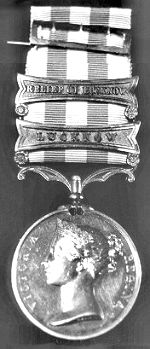 Mutiny medal obverse
Mutiny medal obverse
|
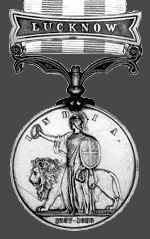 Mutiny medal reverse
Mutiny medal reverse
|
Left - the obverse of the Mutiny medal with clasps for Relief of Lucknow and Lucknow.
Again the diademed head of Queen Victoria with the legend "VICTORIA REGINA." Designed by W. Wyon.
Right - The reverse is the standing helmeted figure of Britannia holding a wreath in her outstretched right hand and over her left arm is the Union Shield. Behind her is the British Lion and above the word "INDIA". The reverse was designed by L. C. Wyon. The ribbon is white with two 1/4" scarlet stripes.
Below - shows the naming on the medal.
 Mutiny medal naming
Mutiny medal naming
|
|
The reasons for the Mutiny:
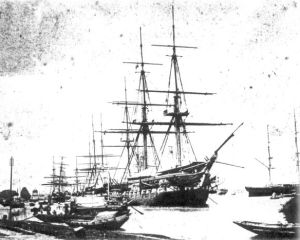 Shannon in Calcutta
Shannon in Calcutta
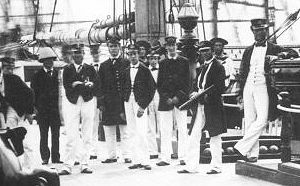 Shannon's Officers on the Quarterdeck,
Shannon's Officers on the Quarterdeck,
Peel standing on the right.
|
The issuing of greased cartridges to the native soldiers was no more the only cause of the Indian Mutiny than was the assassination of the Austrian Archduke Ferdinand, at Sarajevo in July 1914 was the sole reason for the First World War. Both these events were enlarged upon and then used in such a way that only the most gullible person would believe that they, and they, only were the sole cause of the catastrophes that followed.
Trouble in India had been brewing for some time. Serious unrest started after the annexation of the provinces of Oudh and the Punjab in 1856, because the native princes feared they would lose their territories and their thrones.
In July 1855, there was a mutiny of the Sonthals, a tribe of Northern India that was not surpassed until May 1856. On the 7th February 1856, the Province of Oudh (or Oude) was annexed. The King and Queen of Oudh went to London to appeal against this annexation, but to no avail. It is certain that when he returned to India, embittered by what had happened, the King fomented trouble and kindled a hatred against the British presence in the country and the British rule in Particular.
On 6th August she anchored off the Mouths of the Ganges, and on nearing Calcutta was repeatedly cheered by the people on the shore at Garden Reach. At Calcutta Lord Elgin disembarked. Captain Peel offered to the Governor-General the services of the bluejackets of the Shannon, with their ship's guns, to form a Naval Brigade.
|
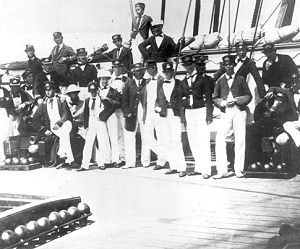 Officer's on Quarterdeck with ready to use cannonballs in foreground.
Officer's on Quarterdeck with ready to use cannonballs in foreground.
|
On the deck of Shannon you can see ready to use cannon-balls. These are kept in place by a device called a shot garland and is made of wood. This method holds the cannonballs in place so they do not roll out of the garland in rough weather. As the shot garland is made of wood it is not likely that the expression 'Cold enough to freeze the balls off a brass monkey', originates from here.
The reason for this change is that the co-efficiency between cast iron and brass is so little this would not alter the size of a brass triangle and as can clearly be seen the cannonballs are in a straight line on a shot garland. I have looked the expression up and the only reference to 'monkeys' are the young lads that carry the powder to the guns, hence the expression 'powder monkeys'.
As I said, when Peel's offer of forming a Naval Brigade was accepted he set off with 454 men with their arms and ammunition and towed on a flat by the Chunar they set off. Captain Peel also took up a launch and cutter belonging to the frigate. They took with them, which were to prove so useful later on, six 68-pounders, two 8 inch howitzers, eight 24-pounders, two small guns and eight rocket tubes. Commander Vaughan was left in charge of the Shannon, but on 18th September, he embarked with reinforcements for the Shannon Brigade, on the river steamer Benares, with Lieutenant Wrenston and another 120 men on the flat with their ammunition. The frigate was left under the command of Mr Waters the Master with about 140 men. Commander Vaughan joined Peel on 20th October in Allahabad. They remained in Allahabad until the 20th October when it left for Cawnpore, being joined on the way by Colonel Powell and part of the 53rd Regiment. The Brigade reached Futtehpore on the 31st. Here it was joined by a detachment of the 93rd Highlanders. On the 1st November, the force attacked the mutineers at Kudjna, where Colonel Powell was killed and Captain Peel assumed command. The mutineers were defeated and the advance to Lucknow was continued. It is worth noting that this must be one of the very rare occasions in which a naval officer has commanded a mixed force in action in the field.
Reaching the Alum Bagh on the 15th November, the Brigade came under the command of Sir Colin Campbell, who ordered it to start bombarding the defences, part of which consisted of the Shah Nujeef, a mosque surrounded by a garden and a high wall, which had been heavily reinforced and defended. This mosque was to be the particular task of the Naval Brigade. The position was defended with great resolution against a heavy cannonade of three hours. It was then stormed in the boldest manner by the 93rd Highlanders, under Brigadier Hope, supported by a battalion of detachments under Major Barnston, Captain Peel leading up his heavy guns with extraordinary gallantry within a few yards of the building to batter the massive stone walls. The withering fire of the Highlanders covered the naval Brigade from great loss, but it was an action almost unparalleled in war. Captain Peel behaved very much as if he had been laying the Shannon alongside an enemy frigate. Four Victoria Crosses were earned in the process of its capture. As at the time the VC was not awarded posthumously I feel certain that William Peel would have received, if not a bar to his VC he would have had another date engraved upon it! The recipients of the VC were Lieutenant Thomas Jones, Lieutenant Nowell Salmon, John Harrison and Captain of the Foretop William Hall who was a Negro from Nova Scotia. Lieutenant Salmon earned his VC for sniping from a tree that he had climbed to get a better view over the wall. Whilst so employed he was kept supplied with loaded rifles by a private of the 93rd. In these days when the mention of the words Combined Operations conjures up visions of fleets of landing craft, bombers and air cover and all the paraphernalia of modern warfare, one likes to think of this sailor, up a tree, 500 miles from the nearest sea, with his ghillie below, giving a very good example of Combined Operations on the 16th November 1857!
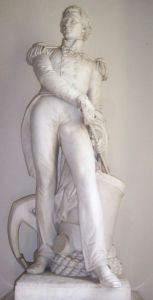
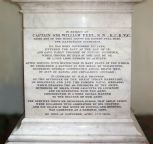
Memorial statue of Captain Sir William Peel in the South Transept of St Swithuns church Sandy in Bedfordshire(UK)
Click the plinth for a closer view.
|
From that time the Shannon's Brigade was present at nearly all of the operations of the Army. Kaye and Malleson, in their "History of the Sepoy Mutiny," say of Peel in Volume 1V page 90, that he was "a man who would have made his mark in any age. To an energy that nothing could daunt, a power that never seemed to tire, he added a freshness of intellect, a fund of resources.... Bright and joyous in the field, with a kind word for every comrade, he caused the sternest duty ordered by him to be looked on as a pleasant pastime.... Starting from Calcutta on an expedition unprecedented in Indian warfare, he conquered every obstacle, he succeeded to the very utmost of the power to succeed. He showed eminently all the qualities of an organizer and leader of men. Not one single speck of failure marred the brightness of his ermine." Peel was everywhere remarkable for his coolness, and his powerful battery did great execution, for he worked and manoeuvred the huge guns as though they were light field pieces. Peel's jacks, as they were called were devoted to him. They marched, and fought, and marched again, as I said earlier they handled their heavy guns like light field pieces, and enduring heat, short rations, disease and fatigue they did it with courage and humour. Peel was always resourceful and cool under any pressure, on one occasion, whilst his guns were bombarding the enemy, restraining Army officers from going forward with the words, "One more broadside please, gentlemen," a remark which, smacking as it did of the sea, amused the Army officers very much. He even had time to invent a form of armoured vehicle known as "Peel's Rocket cars, well they had to find a use for the 8 rocket tubes they had taken with them, they even had a mast in the middle. He also had the time to survey Allahabad's drainage system and make recommendations, none of which were carried out.
On the 21st January 1858, Captain Peel was created a K.C.B. on his appointment as A.D.C. to Queen Victoria this news reached the Brigade about 2nd March, 1858. But in the second Relief of Lucknow he was badly wounded in the thigh by a musket ball, which had to cut out from the opposite side of his leg. Lieutenant Verney procured a carriage and made it as comfortable as he could ready for Captain Peel to travel in it from Lucknow to Cawnpore. This, however, Peel refused to do, saying that if a dhoolie cart was good enough for his bluejackets then it was good enough for him. Unfortunately the cart had previously been used for transporting smallpox victims and Peel contracted the deadly disease! He arrived at Cawnpore on the 17th April and Lord Roberts says in his "Forty-one Years in India", that Peel and he dined together on the 19th when to all appearances he was perfectly well, but on going to his room the next morning ...
"I found him in a high fever, and some suspicious looking spots about his face. I went off at once in search of a doctor, and soon returned with one of the surgeons of the 5th Fusiliers, who to my horror, for I had observed Peel was nervous about himself, exclaimed with brutal frankness, the moment he entered the room, "You have got small-pox!" It was only too true. On being convinced that this was the case, I went to the Chaplain, the Reverend Thomas Moore, and told him of Peel's condition. Without an instant's hesitation he decided that Peel must come to his house to be taken care of. That afternoon I had the poor fellow carried over, and there left him in the kind hands of Mrs Moore who had as a special case been allowed to accompany her husband to Cawnpore."
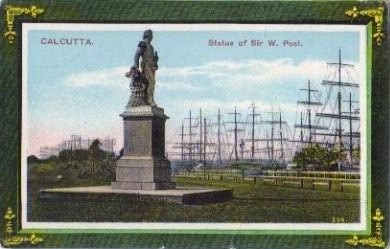
|
Peel died on the 27th April 1858, at the age of 33, just after midnight, and was buried the same day. There were so few troops in Cawnpore at the time that the Reverend Mr Moore had difficulty in forming a burial party. " Eventually, he recorded, only himself and John Bishop, Peel's steward, followed" him whom all England will mourn. The news of his death was brought to the Shannon's Brigade at Lucknow by an officer passing through on his way to Calcutta.
"I cannot say," wrote Lieutenant E. H. Verney, in "The Shannon's Brigade in India" "what a sad loss we all feel this to be, and how deeply his death is felt and regretted by every officer and man; the mainspring that worked the machinery is now gone; we never felt ourselves to be the Shannon's Naval Brigade or the Admiralty Naval Brigade, but always Peel's Naval Brigade. He it was who first originated the idea of sailors going one thousand four hundred miles away from the sea, and afterwards carried it out in such a judicious manner. I do not doubt that his worth will be appreciated and his death deeply lamented by the people of England."
A memorial to the Shannon stands on Clarence Esplanade, Southsea close to the Hovercraft Terminal.
W.H. Russell of The Times wrote of Peel: "The greatness of our loss we shall in all probability never know." A statue of white marble subscribed for by the Army and carved by Theed, was erected in Peel's memory in the Eden Gardens, Calcutta, to commemorate him who was the noblest volunteer of this or any age, who was successful because he was really great and who, dying early, left a reputation without spot, the best inheritance he could leave to his country."
Peel never married and left his estate to his mother for her life and then to his youngest brother, Arthur.
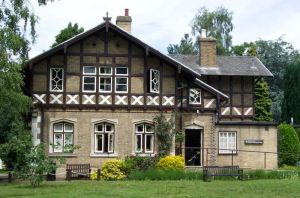
The "Swiss Cottage" at Sandy Lodge.
Built in 1851 for Captain William Peel.
|
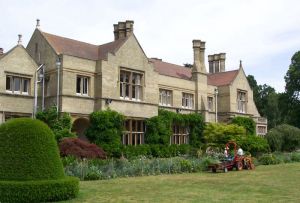 The Lodge at Sandy, Bedfordshire. Built in 1870 for Arthur Wellesley Peel on his estate at Sandy Warren and designed by the architect Henry Clutton.
The Lodge at Sandy, Bedfordshire. Built in 1870 for Arthur Wellesley Peel on his estate at Sandy Warren and designed by the architect Henry Clutton.
|
|
 Mutiny medal obverse
Mutiny medal obverse Mutiny medal reverse
Mutiny medal reverse Shannon in Calcutta
Shannon in Calcutta Shannon's Officers on the Quarterdeck,
Shannon's Officers on the Quarterdeck, Officer's on Quarterdeck with ready to use cannonballs in foreground.
Officer's on Quarterdeck with ready to use cannonballs in foreground.



 The Lodge at Sandy, Bedfordshire. Built in 1870 for Arthur Wellesley Peel on his estate at Sandy Warren and designed by the architect Henry Clutton.
The Lodge at Sandy, Bedfordshire. Built in 1870 for Arthur Wellesley Peel on his estate at Sandy Warren and designed by the architect Henry Clutton.